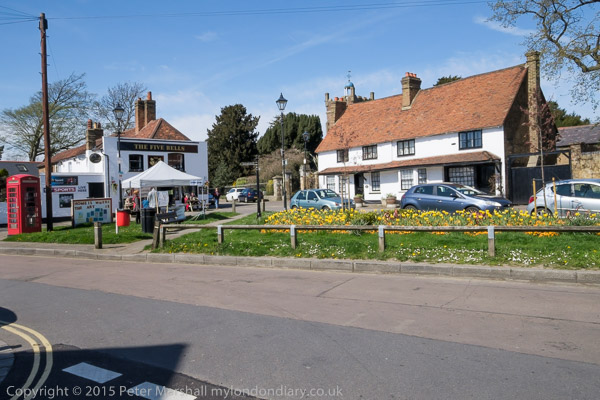
The Village Green at Harmondsworth
The day after I’d photographed the End Immigration Detentionn protest at Harmondsworth’s immigration prison, I got off the bus at the same stop, but instead of walking the few yards towards London turned the other way and took a pleasant footpath alongside the Duke of Northumberland’s River and up to the village of Harmondsworth. It’s a pleasant enough path, but one with a constant reminder of Heathrow, not just in the continual noise from take-offs and landings but also because the path is in the landscaped grounds around ‘Waterside’, the headquarters of British Airways.
The river looks natural now, but was created around 500 years ago in Tudor times to take water from the River Colne at Harmondsworth to the River Crane at Feltham to give a more reliable supply to the watermills on the Duke’s property at Isleworth. Not much else happened to change Harmondsworth until the Colnbrook Bypass was built in the late 1920s, with the Road Research Laboratory set up here (where the prisons now are) in 1930 and a few businesses in the next few years, including Penguin Books, here until the 1990s.
The area south of the Bath Rd changed dramatically after the RAF it took over with the hidden intention of making it into London’s new civil airport after the end of the war. Plans to take over much of the area north of the Bath road were defeated, and aside from a little new housing, Harmondsworth Village remains a small Middlesex village, much as it was when my father cycled around the area before the war.
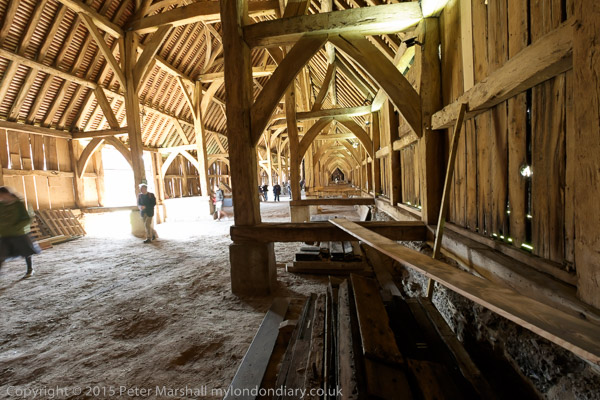
Great Barn interior (image for personal use only)
It has kept its small village green, with a fine church and two pubs (though a third is now a private house.) Take the footpath from the back of the churchyard and across a couple of fields you reach a bridge across the M4, but the fields are still farmed, and just to the west is the Colne Valley Regional Park, with pleasant walks (and bordered by the M25 and its huge junction with the M4.) But most importantly of all it has kept its huge tithe barn, Grade 1 listed, built in 1426 and described by Sir John Betjeman as ‘the Cathedral of Middlesex’ and the largest surviving medieval all-timber building in Britain.
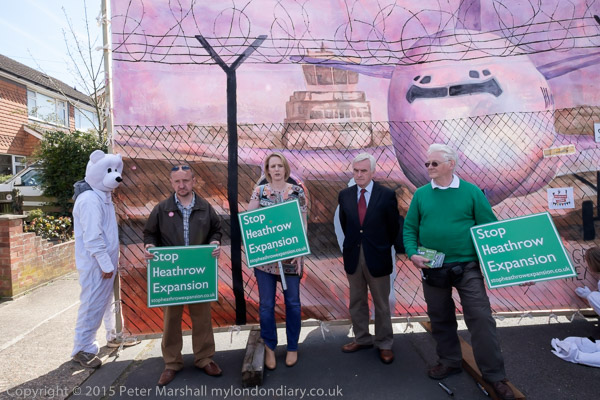
A giant mural where the proposed airport boundary would be, just yards from the Village Green with a polar bear and four general election candidates all opposed to the expansion.
A local campaign led to the barn being bought by English Heritage in 2012 and one of those who led that campaign was local MP John McDonnell (wearing a tie above), who was among those at today’s events, aimed at preserving the area against the latest expansion plans by Heathrow. The report of the Davies Commission was always expected to recommend that Heathrow be allowed to grow yet again, despite that possibility being ruled out a few years ago after massive protests in the area. And even more massive protests can be expected if a further attempt is made. Politically it remains very doubtful if it can ever happen, and perhaps the report will be shelved as have other rather more sensible proposals before it.
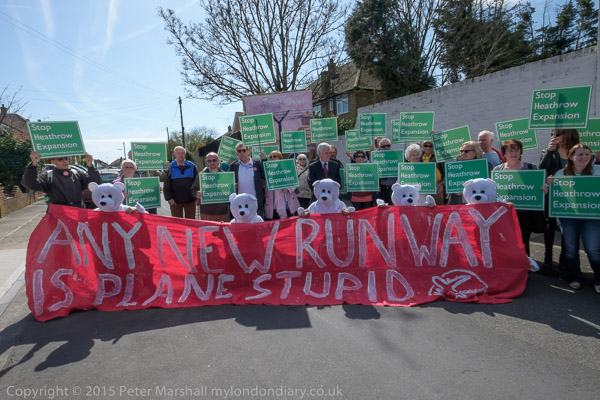
It was a very pleasant afternoon, marred only by the feeling of impending doom. I had taken two Fuji cameras, the X Pro-1 and the X-T1 along with a few lenses, and the bag on my shoulder seemed almost weightless compared to the normal load.
It wasn’t however an entirely satisfactory exercise, as I kept finding both cameras were not working exactly as I expected. I’m just not familiar enough with how they work, and it wasn’t until some weeks later that I managed to sort out one or two problems. Somehow I had managed to lock in an incorrect white balance setting on the XT-1, making everything rather pink (though of course I could correct this in Lightroom) and all too often I still find the fastest way to get either camera to respond to a shutter press is to switch it off and then on again. Batteries as always were a problem, and I’ve now disposed of a couple (one genuine Fuji, another a cheap replacement) that didn’t seem to recharge reliably. But the X-T1 still sometimes seems to run through batteries very fast, and sometimes gets noticeably warm.
I missed a few images when I had to turn the camera on and off, and sometimes focus was just too slow, but most of the pictures were fine. The 10-24mm which I’d recently bought seems to be an excellent lens, as is the 18-55m which I kept on the X Pro-1 all the time. With the X-T1, as well as the 10-24mm I also took a few images on the 8mm Samyang fisheye.
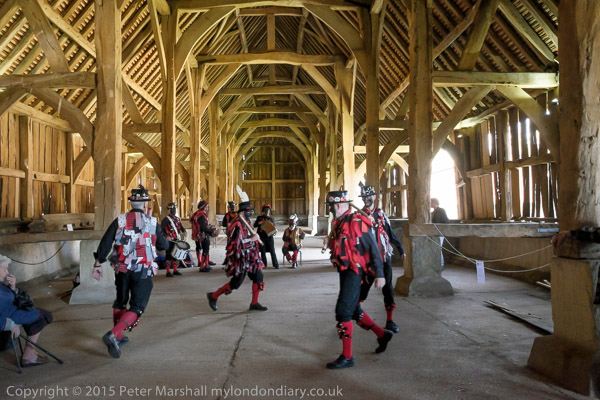
Photographing the Datchet Border Morris dancing inside the Great Barn did present some problems, with movement and relatively low light levels. The light inside the ban was also very uneven, coming mainly from the large doors and some post-processing was needed to even things out. By increasing the ISO setting to ISO6400 I was able to work wide open on the 10-24mm at around 1/100s, enough to stop at least the slower movements in a wide-angle view – the lens is at around 18mm, giving the equivalent of a 27mm view on full frame. A faster lens would not have helped, as I needed to use f4 to give sufficient depth of field – and another half stop down would have been even better. Had I used the 18mm lens at f2.8 the beams would have been noticeably out of focus.
English Heritage have done a fine job in restoring the roof of the barn, which had been neglected for years; it lies just outside the boundary of the expanded airport, but it would be no pleasure to visit should the expansion go ahead (which I think is very unlikely, though it will be a fight to prevent.) The tiles on the roof have been replaced, the new tiles having been specially made for the purpose to the same pattern as those used previously. Photography is allowed on the site, but only for non-commercial use, and you can see quite a few more pictures of its interior – and an exterior view – at Heathrow Villages fight for survival.
______________________________________________________
My London Diary : Buildings of London : River Lea/Lee Valley : London’s Industrial Heritage
All photographs on this and my other sites, unless otherwise stated, are taken by and copyright of Peter Marshall, and are available for reproduction or can be bought as prints.
To order prints or reproduce images
________________________________________________________
http://www.sansmirror.com/newsviews/big-fujifilm-firmware-updat.html
No bigger battery though :-)
You are right, but it really does seem to have made it more responsive. I can live with having to carry three or four batteries.
I was tempted to use it for work this week – less to carry in the heat – but decided I needed to give it a real testing before doing so. I still find the menus and controls a little confusing at the moment. But the 10-24mm really does seem to focus as fast as the Nikon 16-35mm now, and there does seem to be less delay in the camera responding when I lift it to my eye.
Am now thinking more seriously of replacing my ailing D750 with a second X-T1.